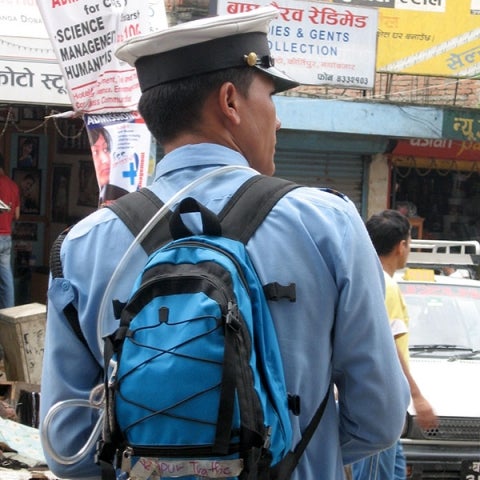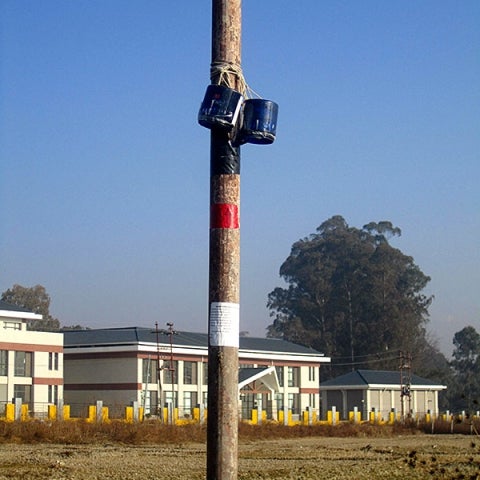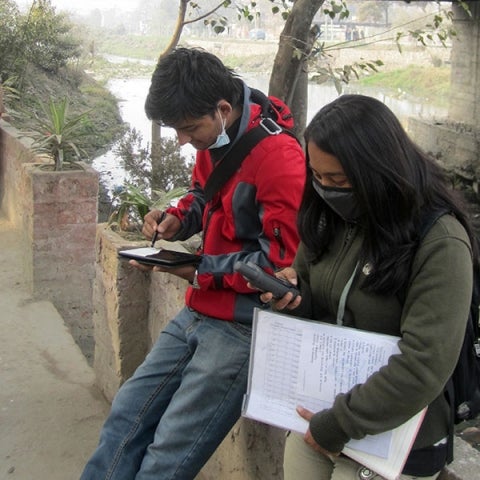Note: Yale School of the Environment (YSE) was formerly known as the Yale School of Forestry & Environmental Studies (F&ES). News articles and events posted prior to July 1, 2020 refer to the School's name at that time.
 Masks for sale in Kathmandu
Masks for sale in Kathmandu
As a graduate student at F&ES, Anobha Gurung ’10 M.E.Sc. heard a lot about research into how air pollution is affecting human health in places across the world. But she wondered if there were any studies being done in her Nepalese homeland where visible signs of increasing air pollution were everywhere.
 A traffic officer being measured for exposure to PM<sub>2.5</sub>
A traffic officer being measured for exposure to PM<sub>2.5</sub>
It turned out there wasn’t much research to draw on. So, in 2009, she went back home and started collecting her own data by attaching small monitors (known as Personal Data Ram) on three-dozen workers to measure personal exposure to airborne fine particles (PM
2.5) based on occupation, location, and proximity to roads. Among those she asked to wear monitors were several traffic police officers who spent each day in the heart of the Kathmandu’s grinding traffic jams.
The data revealed high personal exposure for people who worked both indoors and outdoors, but especially for traffic police. The average exposure for the officers was 51.2 µg/m
3, with an hourly maximum of more than 500 µg/m
3.
“We found that the pollution exposure was really,
really high, suggesting potential for substantial health impacts of air pollution in this region,” says Gurung, who is now a doctoral candidate at F&ES. “And it wasn’t just the traffic police who stand in the middle of the road, but office workers who work farther from the roads.
“We were thinking, ‘Really? Can this be right? Are my instruments really reading this?’ It was
crazy high.”
That study, which was
published in the Journal of Exposure Science and Environmental Epidemiology (and won the student poster competition at the conference for the International Society of Exposure Science), was the first of numerous projects Gurung has launched to get a better handle on whether a rise in pollution across Nepal’s Kathmandu Valley is affecting public health. She is currently working on two additional projects, including the collection of health-related data from regional hospitals and a more comprehensive collection of pollution readings from across the Kathmandu Valley.
She will speak about her work during a panel discussion at this week’s
Himalayan Studies Conference, being held at Yale University.
 View of Kathmandu
View of Kathmandu
Gurung gets back to Kathmandu frequently. And each time she returns, she says, she notices the rapid changes. Some of it has been good, some bad. For instance, when she goes home now she witnesses a grey haze over the valley especially during the winter months and city residents wearing masks.
Most of that pollution, she says, is a product of the influx of new vehicles on the city’s roads.
“In Asia, urban air pollution in many cities rivals the levels that existed during the first decades of the 20
th century in Europe and North America and account for a large proportion of global health burden in relation to air pollution,” she says. “Although air pollution and human health have been extensively studied in the West, there are important limitations to extrapolating health effects based on Western cities to developing Asian cities.
“Studies in places like Kathmandu are important where rapid urbanization is leading to considerable deterioration of air quality.”
In addition to the air monitoring study, Gurung recently published a study
in the journal Environmental Research that reviewed the scientific evidence of air pollution effects across Nepal. Like many other developing regions, the study revealed a lack of research. And the few studies that were done indicated high pollution levels withpotentially serious health consequences.
Finding enormous gaps, she is now conducting two separate studies to advance this field. One involves collecting a mountain of patient data from six hospitals in Kathmandu Valley that she hopes will reveal insights into the association between ambient particulate matter and hospital admissions as well as susceptibility based on individual and community characteristics.
 Installation of Palmes tubes under protective cover for NO<sub>2</sub> measurement.
Installation of Palmes tubes under protective cover for NO<sub>2</sub> measurement.
In another ongoing study, she is measuring levels of nitrogen dioxide (NO
2) across the urban areas in Kathmandu Valley. Measuring NO
2 is an attractive option, she says, because of its low sampling costs, ease of measurement, and its wide use as a surrogate for traffic exposure.
Anobha Gurung says her research has been inspired by the work of
Michelle Bell, a F&ES professor of environmental health whose research group is exploring the links between pollution and human health by integrating various disciplines, including epidemiology, biostatistics, and environmental engineering.
Bell, who is now her advisor, says Gurung’s research is providing the best information to date on how air pollution affects health in Kathmandu. Collection of that data has involved working with a range of community members.
“She recognizes the need to coordinate with in-country researchers as well as local communities and has established an incredibly strong network of local collaborators and stakeholders,” Bell said. “Her work has tremendous potential to improve public health.”
Earlier this winter, Gurung started the fieldwork for her latest study, installing 135 monitors over two weeks outside residential homes and commercial shops in urban areas across Kathmandu Valley. She’ll repeat the process three times this year for each season, creating a valuable model to understand exposure to traffic-related pollution.
“This work is critical for future epidemiological studies, identification of hotspots, and effective policies for air pollution control and human health protection,” she says. “A goal of this project is to develop a flexible methodology for exposure assessment suitable for Asian cities like Kathmandu making use of readily available data and cost effective technologies, helping to provide framework for future research in areas with limited resources.”
 Volunteers conduct environmental asessments at sites in Kathmandu.
Volunteers conduct environmental asessments at sites in Kathmandu.
When she was selecting the locations to install the monitors, she spoke with community members at each site, asking permission to use their property and then requesting that they keep an eye on the equipment.
“It was a great chance to interact with the community,” she says. “They had so many wonderful questions about air pollution and talked about problems they are facing as a result. For me that was the most exciting part.
“I’m hoping that when we go back in April, when we do the next round of the campaign, that we can take some of this information back that we measured and give it to the shopkeepers. At least at 135 locations, people will gain awareness of levels of exposure to traffic related air pollution and its impact.”
The work has already involved dozens of trips across the valley region, often on a motorbike, to prepare and keep track of the data collection. It requires a lot of labor, and can take a physical toll.
“On my most recent trip, I came back after being on a bike all day and thought, I actually know where my tailbone is now!” she says with a laugh. “Everyday I was excited to go back to the field, I have definitely found my passion!”
 Masks for sale in Kathmandu
Masks for sale in Kathmandu
 A traffic officer being measured for exposure to PM<sub>2.5</sub>
A traffic officer being measured for exposure to PM<sub>2.5</sub>
 View of Kathmandu
View of Kathmandu
 Installation of Palmes tubes under protective cover for NO<sub>2</sub> measurement.
Installation of Palmes tubes under protective cover for NO<sub>2</sub> measurement.
 Volunteers conduct environmental asessments at sites in Kathmandu.
Volunteers conduct environmental asessments at sites in Kathmandu.